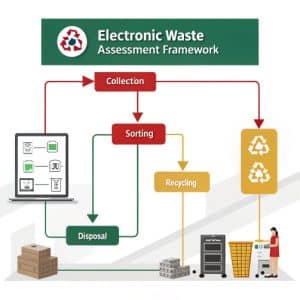
Introduction
Electronic waste (e-waste) represents one of the fastest-growing waste streams globally, with over 54 million tonnes generated annually. As a sustainability consultant specializing in electronic waste management, I’ve developed a comprehensive framework for assessing whether electronic devices have reached the end of their useful life. This assessment methodology helps individuals and organizations make informed decisions about device retention, repair, or responsible disposal.
Assessment Framework
When evaluating electronic devices, I consider four critical factors that determine their lifecycle status:
Functionality: The device’s current operational capability and performance relative to its intended purpose. This includes both primary functions and safety considerations.
Age and Technology Relevance: How current the device technology remains and whether it can still meet modern usage requirements, including compatibility with current software and connectivity standards.
Repairability: The feasibility and cost-effectiveness of repairs, considering parts availability, technical complexity, and economic viability compared to replacement costs.
Market and Residual Value: The device’s remaining economic value, either for continued use, resale, or component recovery.
Classification Categories
Still Useful
Devices in this category retain significant functionality and value. They may show minor wear but continue to serve their intended purpose effectively. These devices should remain in active use, potentially with minor maintenance or updates.
Characteristics:
- Core functions operate reliably
- Compatible with current software/connectivity standards
- Minor cosmetic wear acceptable
- Repair costs (if needed) represent less than 40% of replacement value
- Market demand exists for similar devices
Needs Repair
These devices have identifiable issues that prevent optimal operation but possess sufficient value to justify repair investment. The repair process should restore them to useful condition while remaining economically sensible.
Characteristics:
- Primary functions compromised but repairable
- Repair costs between 40-70% of replacement value
- Parts readily available
- Post-repair lifespan expected to exceed 2 years
- Device age typically under 7-10 years depending on category
End of Life
Devices requiring responsible disposal or recycling. Repair costs exceed economic viability, or the technology has become obsolete beyond practical use. Focus shifts to material recovery and proper waste management.
Characteristics:
- Repair costs exceed 70% of replacement value
- Critical components no longer available
- Technology obsolescence prevents effective use
- Safety concerns due to degradation
- Minimal residual market value
Assessment Considerations by Device Category
Computing Devices
Desktop computers and laptops often have extended useful lives through component upgrades. However, processor architecture changes and operating system compatibility eventually limit their viability. Devices over 8-10 years old frequently fall into end-of-life categories unless maintained for specific legacy applications.
Mobile Devices
Smartphones and tablets face rapid technological advancement cycles. Battery degradation, operating system support termination, and app compatibility issues typically drive replacement cycles of 3-5 years. However, devices with replaceable batteries or strong secondary market demand may extend useful life.
Home Appliances
Large appliances generally justify repair investment due to high replacement costs. Critical factors include compressor functionality in refrigeration units, motor condition in washing machines, and heating element integrity in ovens. Age considerations vary significantly by appliance type and build quality.
Audio-Visual Equipment
Televisions, audio systems, and related equipment often maintain functionality well beyond technological relevance. Digital compatibility, resolution standards, and connectivity options frequently determine useful life more than mechanical failure.
Sustainable Decision-Making Guidelines
Repair Prioritization
Prioritize repairs for devices with:
- High replacement costs
- Specialized or professional applications
- Emotional or historical value
- Strong environmental impact from replacement
Responsible Disposal Pathways
For end-of-life devices:
- Utilize certified e-waste recycling facilities
- Remove and securely wipe personal data
- Consider manufacturer take-back programs
- Explore component harvesting for repair purposes
Extension Strategies
Maximize device lifespan through:
- Regular maintenance and cleaning
- Software optimization and updates
- Component upgrades where feasible
- Protective accessories and proper storage
Economic and Environmental Impact
The assessment framework balances economic practicality with environmental responsibility. Premature disposal wastes embedded energy and materials, while excessive repair investment may delay adoption of more efficient technologies. The optimal approach considers total cost of ownership, including energy efficiency improvements in newer devices.
Implementation Recommendations
Organizations implementing this framework should:
- Train staff on assessment criteria
- Establish repair cost thresholds aligned with budget constraints
- Develop relationships with certified repair services and recycling facilities
- Maintain inventory tracking for lifecycle management
- Consider leasing arrangements that include end-of-life management
Conclusion
Effective electronic waste management requires systematic evaluation of device condition, repair feasibility, and lifecycle positioning. This framework provides a structured approach to maximize device utility while ensuring responsible disposal when equipment reaches true end-of-life status. By applying these principles consistently, we can significantly reduce electronic waste generation while maintaining operational efficiency and cost-effectiveness.
The key to successful implementation lies in regular assessment, proactive maintenance, and commitment to sustainable practices throughout the device lifecycle. As technology continues advancing rapidly, these evaluation skills become increasingly valuable for both economic and environmental stewardship.

